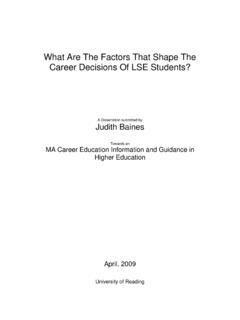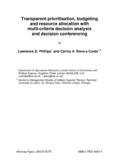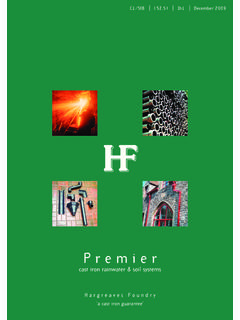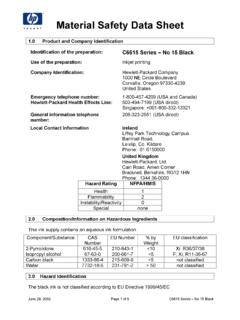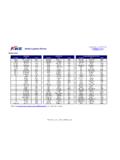Transcription of C THE REGULATION OF PHARMACIES ABROAD
1 24 The control of entry regulations andretail pharmacy services in the UKJanuary 2003 CTHE REGULATION OF PHARMACIES This annexe provides a descriptive overview of how community PHARMACIES areregulated around the world with a particular focus on the impact oncompetition. This study was commissioned for the investigation. It is theresponsibility of the authors and any views expressed in them are those of theauthors and not necessarily of the The OFT commissioned Dr Elias Mossialos and Dr Monique Mrazek from theLondon School of Economics to undertake a study of pharmacy REGULATION in sixOECD In addition, a brief overview of the pharmacy regulations in the Republic ofIreland is presented.
2 The Irish regulations can be described as being in a state offlux. The regulations that were put in place in 1996 were ruled to be ultra viresearlier this year and a Review Group has been set up to recommend a Overall, pharmacy regulations vary considerably around the world, reflectingdifferences in healthcare systems, the financing of those healthcare systemsand historical REGULATION changes in the Republic of There are around 1,280 PHARMACIES in Ireland (or one per 3,040 people). Medicines in Ireland have broadly similar regulations on distribution as does theUK. That is, some are only available on prescription, some can only bepurchased in the presence of a pharmacist while some OTCs ( asprin,paracetamol and cough medicines) are available in non-pharmacy , whereas around 75 per cent of non-prescription medicines in the UKare sold in PHARMACIES , the figure for Ireland is almost 90 per Ownership regulations are also similar to the uk corporate bodies are allowedto own community PHARMACIES and there is no restriction on the number ofoutlets per owner.
3 However, until recently, there have been tight restrictions onthe location of In 1996, regulations were introduced making entry to the General MedicalServices (GMS) dispensing market more For example, under the 29 AESGP (2001).30 Broadly, the GMS is the Irish equivalent of the NHS. As with the uk and the NHS, there arefew restrictions on setting up a non-GMS dispensing pharmacy in Ireland. But also like the UKand NHS, in the large majority of cases PHARMACIES need a GMS dispensing contract to beviable (Competition Authority, 2001).Office of Fair Trading25new regulations , PHARMACIES could not open within 250 metres of an existingpharmacy in urban areas or within 5 kilometres in rural areas.
4 In addition, PHARMACIES were required to pas a needs test . In urban areas, the pharmacyapplying for a contract must have been able to prove that at least 4,000 peoplein the area were not being adequately served by existing PHARMACIES (2,500people in rural areas). Further, the new pharmacy must be viable and notadversely impact on the viability of existing In 2001, the Organisation for Economic Co-operation and Development (OECD)raised competition concerns about some of the regulations governing These included pharmacy, with particular criticism directed at therestrictive location requirements of new PHARMACIES and the ownershiprequirements (pharmacists not trained at Trinity College, Dublin, were preventedfrom opening a pharmacy within their first three years of working in Ireland).
5 Around the same time a number of pharmacists, as well as the Irish Consumers Association, challenged the legality of the location and ownership restrictions inthe Irish courts. In January 2002, the Irish Attorney General ruled theregulations to be ultra At present, no regulations are in force. Health Boards across the country havehad various responses to this some have stopped issuing new contracts untilnew regulations are In the meantime, a Pharmacy Review Group has been established, comprisingofficials from across Government and pharmacy representative terms of reference of the group is to review the pharmacy regulations with(among others) a view to:34 maximising the potential to increase competition within the sector with aview to ensuring lower prices and improved services to the consumers assessing and responding to the recommendations in the OECD report onrestrictions on the location of PHARMACIES while ensuring, in so far as ispossible, a reasonable spread of PHARMACIES so that the service isconvenient to the consumer ensuring a high quality pharmacy service in remote and deprived areas (toinclude an assessment of the dispensing doctors scheme) 31 Competition Authority (2001).
6 32 OECD (2001).33 The Department of Health in Ireland has not released the details of the Department of Health (Ireland) ( )26 The control of entry regulations andretail pharmacy services in the UKJanuary 2003 Ensuring that the opening hours of PHARMACIES facilitate consumers andmeet all reasonable health needs of the population in its area, and Considering how a universal service and public service obligation can beidentified and met and assessing any funding consequences which of Fair Trading27 The REGULATION of PHARMACIES inSix CountriesReport prepared for the Office ofFair TradingElias Mossialos MD PhD & Monique Mrazek PhDLSE Health & Social Care and theEuropean Observatory on Health Care SystemsAcknowledgementsWe would like to thank David J.
7 Bougher, Bj rn Finke, Nadia Jemiai, Hans Maarse,Kirsten Myhr and Karen Smilski who contributed to this study, and Anna Maresso forher editorial assistance. All remaining errors are those of Elias Mossialos and control of entry regulations andretail pharmacy services in the UKJanuary 2003 TABLE OF and comparative The United States70 Appendix A: Overview Of Health Care Funding And Delivery76 Office of Fair INTRODUCTION AND COMPARATIVE OVERVIEWThe aim of this study is to provide a brief overview of the laws and regulationsgoverning the retail pharmacy sector that impact on competition between pharmaciesin six OECD countries.
8 As part of the Office of Fair Trading investigation into the entrycontrols to the retail pharmacy market in the United Kingdom, this study describes howretail pharmacy is governed in other countries, in particular the extent to which entry iscontrolled and PHARMACIES compete. The countries covered by this study are Canada,France, Germany, the Netherlands, Norway and the United States (USA). The countrieswere selected on the basis of the diversity of the their systems for financing anddelivering health care, as well as for the structure and extent of REGULATION in theirpharmacy market. This report covers developments in the pharmacy markets of thesecountries up to June study examines the retail pharmacy sector in each of the selected countries alongfour main parameters: pharmacy numbers, restrictions of entry, restrictions ofownership and restrictions on price.
9 The first section in each country case-study looksat the relationship between the ratio of PHARMACIES and pharmacists to the data is available, a time trend for comparison is included. This is followedby the examination of restrictions of entry in each country including whether there arerestrictions on the location of new PHARMACIES and whether a licence or contract isrequired for dispensing prescribed drugs. Questions such as whether there arerestrictions on ownership structure or the number of PHARMACIES per owner areexamined in the section on restrictions of ownership. Finally, regulations limiting theretail prices of prescribed drugs are appendix (Appendix A) to this study provides a brief overview of the mechanismsfor financing and delivering health care in the selected countries.
10 It includesrequirements for co-payments and the limits to product findings of country case-studiesEach case study in this report examined the pharmacy market in the selected countriesthat considered market structure, REGULATION and competitive potential. Key differencesbetween countries were observed in terms of market structure and the extent ofregulation in the markets. Market structure and the extent of competition in the marketare extensively determined by the regulations in place. For example, regulations thatlimit the chaining of PHARMACIES and the location of PHARMACIES are importantdeterminants of the extent of competition in the retail pharmacy results of this study are summarised in the table control of entry regulations andretail pharmacy services in the UKJanuary 2003 Table REGULATION of PHARMACIES in six countriesFranceGermanyNetherlandsNorway USA CanadaLicense orcontractrequired?




